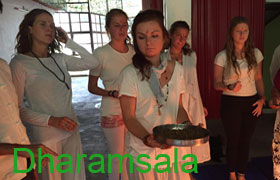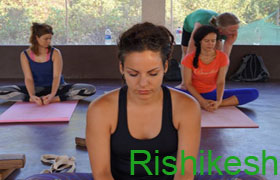Tribandha for Pranayama Sadhana
Bandha means lock or fastening. The energy which flows out of your body is blocked and the entire energy is directed to be focused into the soul. There are three main types of bandhas. The training provided by Yoga faculty for these bandhas as a part of the yoga teacher training in Goa is famous throughout the world.
Jalandhara Bandha
You should start by sitting in padmasana or siddhasana. Close one of your nostrils and inhale air through the other nostril. Now raise your neck slightly upwards and bring it front. Bend forward and make your chin slightly press against your chest. Consequently you should be able to apply pressure on trachea and oesophagus and close them so that no air can enter into the body or exit and also no saliva can get in. This means the upper entrance into the body is completely closed. Thus the air existing inside your body now cannot exit unless you release this bandha. This kriya is called Jalandhar bandha. You should notice here that Jalandhar bandha is to just not press your chin against your chest externally but you should actually close the path into the body so that not even air can pass in.
Benefits: This bandha is a part of pranayama. Thus the benefits of this bandha are also interlinked to those of pranayama. When you practice this bandha as the cervical nerve is closed, the flow through the nerves from head to the remaining parts of the body is blocked. Thus the nectar constantly dripping from the moon placed in brahmatalu will not flow down. Hence until this bandha is released, it is blocked and absorbed in the upper part of the body and reinforces it. Eventually the yoga seeker will be able to control his longevity and death. Apart from this it improves the functionality of all the glands situated in the neck region namely thyroid, parathyroid, tonsils and salivary glands. These glands release the hormones responsible for the strength, glow, beauty and juvenility in one’s body. The practice of this bandha makes these glands work with improved efficiency in a natural process, which eventually makes the yoga seekers body fill with strength, glow, beauty and juvenility and stabilises it. In this way, this bandha supports pranayama and cause our life to become content in all spheres.
Moola Bandha
Jalandhara bandha blocks the path and prevents the life energy from moving downwards whereas moola bandha blocks the remaining paths. Our body has two outlets downwards. They are the anus and the urinary tract. The anus is called guda indriya and this itself is the shankini nadi. The urinary tract is called the kuhu nadi which controls the urine and semen.
The urinary tract and the anus are compressed in order to practice moola bandha. Therefore, the shankini nadi and kuhu nadi are both dragged upwards. To do this you should try to raise the fart upwards. Thus the process of contraction of the shankini nadi and the kuhu nadi together is called moola bandha.
Moola bandha is always practiced along with pranayama. But the practice of moola bandha will be easier for a yoga seeker if he practices ashwini mudra for few days prior to it. Ashwini mudra involves contraction and relaxation of shankini nadi repeatedly. This kriya can be practiced without pranayama. Once the seeker learns to this mudra, he would find not difficulty in practicing moola bandha. Although ashwini mudra involves the contraction of shankini nadi only unlike moola bandha which includes the involvement of both shankini and kuhu nadis.
Pranayama is started with poorak followed by kumbhak along with the application of Jalandhara bandha. Then moola bandha followed by uddiyana bandha are observed. Finally these bandhas are released in the reverse order that is, uddiyana bandha is released first and followed by the moola bandha and the jalandhara bandha.
Benefiits: The practice of moola bandha is the key to all kinds of successes. Mysterious powers are derived from the practice of this bandha. Among the list of the advantages of this bandha reinforcement of urinary duct and semen duct stand first. Consequently, it can eradicate any disease pertaining to excretory and reproductive systems such as constipation, piles, fistula-in-ano, gonorrhea weakness, premature ejaculation, impotence, etc. Through the constant practice of this bandha the yoga seeker will be able to acquire the capability to live in chastity. Thus his semen is never lost. Consequently a phenomenal improvement can be seen in energy, strength, intellect and memory. Eventually the seeker can even attain control over age and longevity. Moolbandha remains the core reason for every type of yogic attainment.
As mentioned already, the consistent practice moolabandha (contraction of shankini and kuhu nadis) is the key to endless kinds of successes. In order to understand its potential we need to first understand the human body design in this area. This bandha mostly deals with the reproductive system of the human body. There are two egg shaped parts pertaining to genitals of human body which are called testis. These parts vary in design and functionality from each other in male and female human bodies. These are located internally in the female human body. This part produces and discharges eggs every month which causes for the appearance of menstrual cycle and gives them the ability to get conceived for a certain number of days. In men, testis causes for the production of sperms. It consists of blood circulation also in it to an extent. Semen is produced from blood in the young age which gets collected in testis. There is a nadi which is split into both parts of testis. This nadi is called veeryavahini nadi. One end of this nerve is found in the downstream of the urinary tract while the other end is found in the main artery of the heart. The end situated in the downstream opens up when the body is stimulated through the sexual desire. The semen then drives out through this opening. If this nerve is weak, the semen might get diluted and discharged through this route even without any stimulation. In any other circumstances, the semen flows upwards and dissolves into the blood. This blending of semen into the blood is the main cause for the physical strength, brightness, energy, power, beauty and juvenility in a human body. The practice of moolabandha is the only way to make both veeryavahini nadi and testis powerful and active. Consequently the production of semen will be increased and also instead of being discharged off through the downstream route, it flows upwards and gets dissolved into the blood. A person who practices moolabandha continuously and strengthens the veeryavahini nadi such that it increases the production of semen and not allows it to be discharged downstream instead enables it to get blended into blood is called urdhvaretha.
Uddiyana bandha
In order to practice uddiyana bandha you should first sit in padmasana or siddhasana. Follow the instructions in the topics discussed further regarding various types of pranayama. Observer jalandhara bandha followed by kumbhak. Contract the front portion of your belly and pull it inside to the extent possible. This can be practiced in the standing posture too.
Benefits:
With the practice of this posture, all the diseases associated with the spleen, stomach, duodenum and the intestines can be eliminated. Hunger is extremely increased. The combination od pana and apana takes place which clears the impurities like mucus and sewage accumulated over the sushumna nadi. Consequently sushumna nadi opens up and awakens the kundalini in turn. Eventually the yoga seeker can conquer the process of aging and death because this kriya ia an integral part of pranayama. Thus the amount of practice and time spent on this depends in the amount of practice and time spent on pranayama.
While practicing pranayama, these bandhas are practiced in a predefined order after the practice of purak kriya. One should follow this predefined order. Jalandhara bandha, moolabandha and uddiyana bandha constitutes the order. The releasing order of these bandhas is in the reverse order. Thus one should first release uddiyan bandha followed by moola bandha and jalandhara bandha. A yoga seeker can attain success in kumbhak only after consistent practice of these bandhas for few months. If a yoga seeker practices pranayama for eighty times daily continously in the morning, evening, mid-day and mid night, he can achieve kumbhak in six months. Pranayama cannot impart its benefits completely without bandhas.
Maha Bandha
Sit in any meditative posture and exhale. Maintain vacuum inside your body ( no air). Now observe jalandhara bandha, moola bandha and uddiyana bandha in order. Pause in this posture as per your stamina and try to meditate over all the chakras ranging from mooladhaara to sahastrar chakra. Now release uddiyana bandha followed by moola bandha and jalandhara bandha. This constitutes one cycle of maha bandha. This can be repeated for 11 chakras.
Precautions: Pregnanat ladies should not practice this. People suffering with hernia, high BP or low BP, ulcer or heart problem should not practice this.
Benefits:
It is very helpful in awakening the energy centers in your body. We can avail all the benefits of moola bandha, jalandhara bandha and uddiyana bandha through the practice of maha bandha. Maha bandha is highly beneficial in making our mind afferent.
The yoga teacher training in Rishikesh is well known for its special attention it dedicates for the training of these bandhas.




